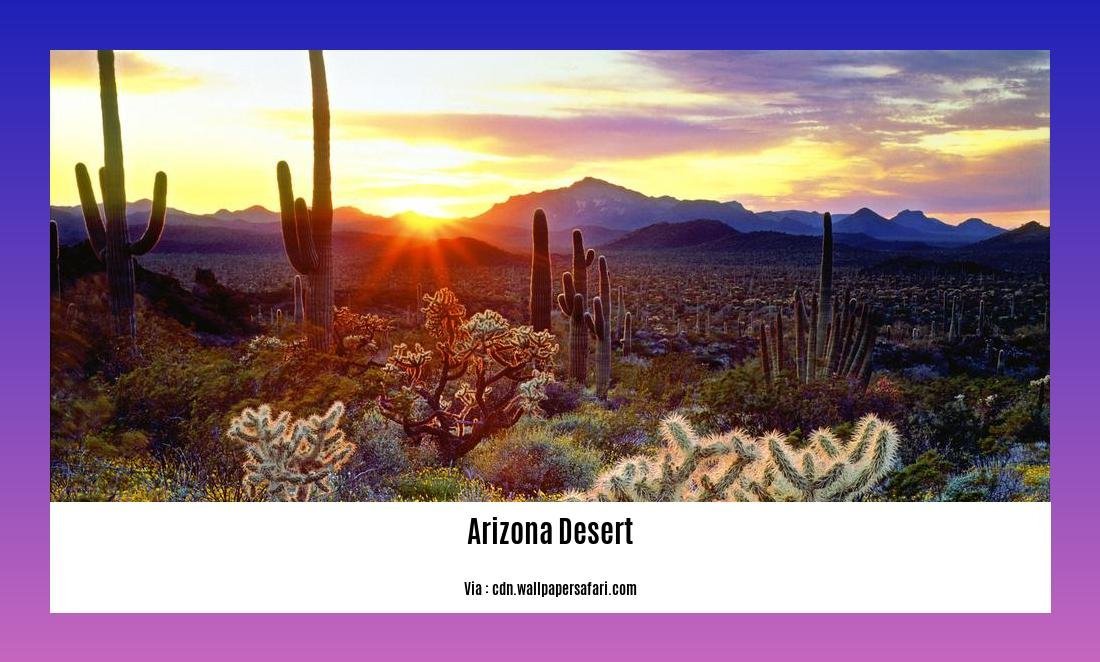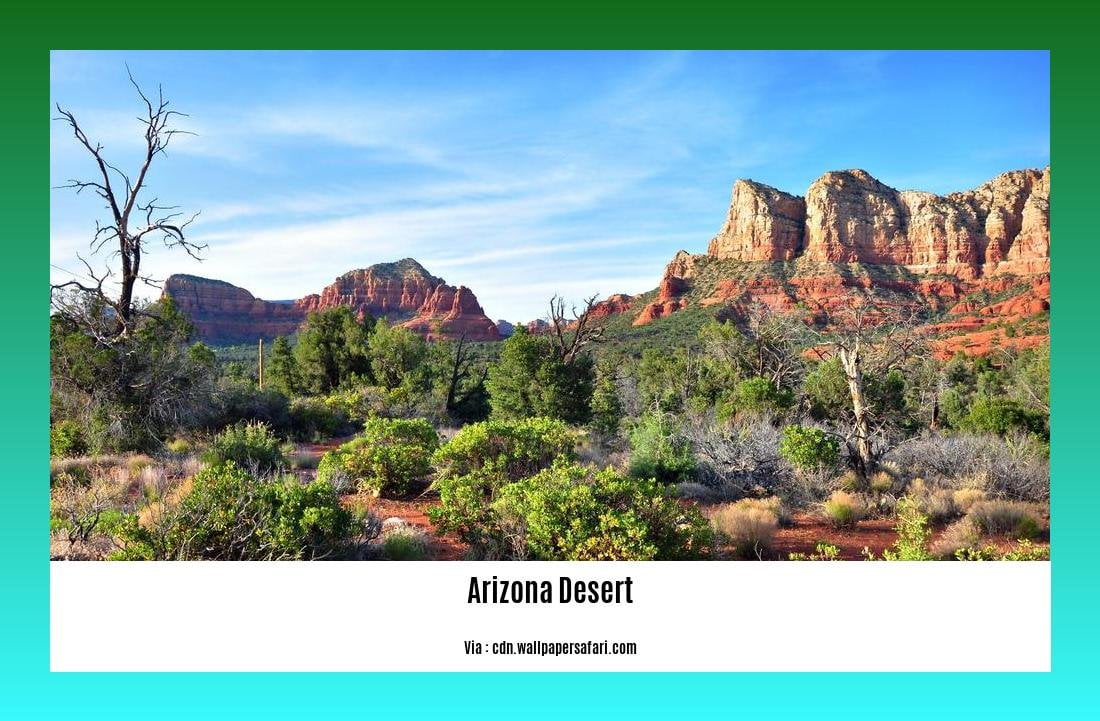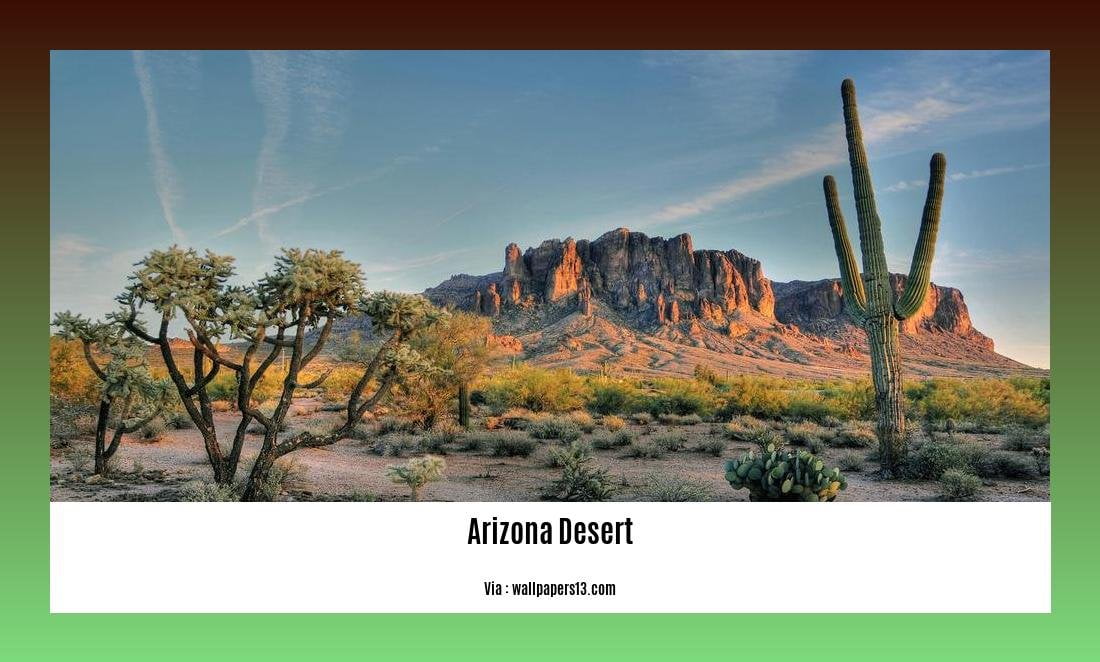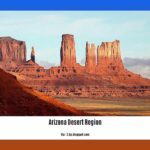Unveiling Arizona Desert Facts: A Deep Dive into the Captivating Beauty of the Arid Ecosystem
Prepare to embark on a captivating journey through the spellbinding wonders of the Arizona desert. In this article, we will peel back the layers of this unique and awe-inspiring ecosystem, delving into fascinating facts that will leave you with a profound appreciation for its boundless beauty. From its resilient flora and fauna to its rich indigenous cultures, this arid landscape holds secrets waiting to be uncovered. Join us as we delve into the intriguing realm of Arizona desert facts and discover the true magnificence that lies within.
Key Takeaways:
- The Painted Desert in Arizona is a protected area that is approximately 120 miles long and 60 miles wide. It is known for its unique colors and rock formations.
- The layers of the Painted Desert are made up of various sediments that took millions of years to form.
- The vibrant colors of the Painted Desert are a result of iron and manganese compounds in the sediments.
- The Sonoran Desert, located in southeastern California and southwestern Arizona, is another arid region known for its unique flora and fauna.
- The Sonoran Desert is home to the iconic Saguaro Cactus, which can grow to be 50 feet tall and live for over 200 years.
- The Sonoran Desert is also home to a diverse range of animals, including birds, reptiles, and amphibians.
- The Sonoran Desert spans approximately 100,000 square miles across multiple states and regions.
Arizona Desert Facts

The Arizona desert is a captivating ecosystem that holds numerous wonders waiting to be unveiled. In this article, we will delve into the unique features and intriguing facts about this arid region. From the vibrant colors of the Painted Desert to the iconic Saguaro Cactus of the Sonoran Desert, let’s embark on a journey to discover the captivating beauty of the Arizona desert.
The Painted Desert: A Mesmerizing Landscape
The Painted Desert, located in Arizona, stretches an impressive 120 miles long and 60 miles wide [^1^]. Protected and limited in terms of motorized travel, this natural wonder has been shaped over millions of years through the deposition of various sediments [^1^]. Its name is derived from the diverse hues and shades of the rocks and sediments, creating a picturesque spectacle resembling a painted cake [^1^]. Thanks to the presence of iron and manganese compounds, the layers of the Painted Desert radiate an array of vibrant colors that leave visitors in awe [^1^].
The Sonoran Desert: Nature’s Masterpiece
Another remarkable desert in Arizona is the Sonoran Desert, extending across southeastern California and southwestern Arizona. This arid region is renowned for its exceptional flora and fauna, as well as its cultural significance [^2^]. In 2001, the Sonoran Desert National Monument was established to safeguard the ecological and cultural resources of the area, highlighting its value [^2^].
Flora and Fauna of the Sonoran Desert
One of the most iconic plants found in the Sonoran Desert is the Saguaro Cactus. Towering up to an impressive height of 50 feet and with a lifespan exceeding 200 years, these majestic cacti stand as symbols of endurance and resilience [^2^]. As we explore this unique desert, we encounter an exceptional range of animal species as well. The Sonoran Desert is home to a diverse array of reptiles, including Gila monsters, ornate box turtles, desert tortoises, and rattlesnakes. Many reptile enthusiasts, both casual and professional, flock to this region to witness their incredible diversity [^3^].
The desert also serves as a haven for an abundance of birds, including raptors, California condors, and falcons, captivating both birdwatchers and nature enthusiasts with their impressive flight skills and mesmerizing beauty [^3^]. Moreover, the endangered Sonoran tiger salamander finds its refuge in the unique habitats of this desert, underscoring the importance of conserving this delicate ecosystem [^3^].
Exploring the Vast Arizona Desert
Covering a vast expanse of approximately 100,000 square miles, the Sonoran Desert stretches across southwest Arizona, southeast California, Baja California, and the western half of the Mexican state of Sonora [^3^]. This expansive region showcases the harmonious coexistence of diverse landscapes, flora, and fauna, ultimately contributing to the unparalleled beauty of the Arizona desert.
In conclusion, the Arizona desert stands as a testament to the extraordinary wonders of our planet’s diverse landscapes. From the breathtaking hues of the Painted Desert to the magnificent flora and fauna of the Sonoran Desert, there is no shortage of captivating beauty waiting to be discovered. This arid ecosystem not only showcases nature’s resilience but also serves as a reminder of our responsibility to appreciate and protect these fragile environments. So, are you ready to embark on an unforgettable journey through the arid wonderland of the Arizona desert?
References:
[^1^]: 10 Facts About Arizona’s Painted Desert
[^2^]: Arizona Desert Facts: How Big Is It, What Plants Can You Find And More
[^3^]: Arizona Pictures and Facts – National Geographic Kids
Argentina is known for its diverse culture, breathtaking landscapes, and vibrant cities. If you want to discover some fascinating facts about Argentina, click here to learn more about this enchanting country.
When it comes to Argentina, its culture is as remarkable as its natural beauty. Experience the rich traditions and customs by exploring some interesting fun facts about Argentina’s culture, just click here to dive into an immersive cultural journey.
¿Quieres saber algunos datos divertidos sobre Argentina en español? Haz clic aquí para descubrir información fascinante sobre este hermoso país en tu idioma preferido.
Are you curious about the Arizona desert region? Uncover intriguing facts about this unique landscape and its captivating beauty by clicking here to learn more.
Ecosystems and Adaptations in the Arizona Desert

The Arizona desert is a land of breathtaking beauty and harsh conditions. With its unique ecosystems and fascinating adaptations, this arid landscape holds a wealth of wonders waiting to be discovered. In this article, we delve deep into the captivating world of the Arizona desert, exploring the diverse flora, fauna, climate, and indigenous cultures that call this place home.
Exploring the Arizona Desert
The Arizona desert is part of the larger Sonoran Desert, which stretches across parts of California, Arizona, and even into Mexico. This arid region is known for its distinctive geography and fascinating features. From the towering saguaro cacti to the expansive sand dunes, the Arizona desert showcases a landscape unlike any other.
Ecosystems in the Arizona Desert
Within the Arizona desert, various ecosystems thrive, each with its own unique characteristics and adaptations. The desert sustains remarkable biodiversity, providing a home for numerous plant and animal species. These ecosystems have evolved over time to survive the extreme temperatures, limited water, and arid conditions that dominate the desert environment.
One of the most iconic ecosystems in the Arizona desert is the saguaro cactus forest. These towering giants can reach heights of up to 50 feet and can live for over 200 years. The saguaro cactus provides shelter and food for a variety of desert creatures, offering a prime example of the interconnectedness of desert ecosystems.
Adaptations in the Arizona Desert
Surviving in the harsh Arizona desert requires unique adaptations. Desert plants have developed strategies to conserve water and maximize their chances of survival. Some plants have long taproots that reach deep into the ground to access precious water sources hidden beneath the surface. Others have adapted to store water in their leaves or stems, allowing them to withstand long periods of drought.
Animals in the Arizona desert have also developed remarkable survival skills. From camouflage that helps them blend into their environment to specialized physiological adaptations, desert animals have honed their abilities to thrive in this challenging ecosystem. Some animals, like the desert tortoise, burrow underground to escape the scorching heat, while others, like the roadrunner, have long legs for traversing the desert sands swiftly.
Key Takeaways:
- The Arizona desert is part of the larger Sonoran Desert, stretching across parts of California, Arizona, and Mexico.
- The desert is characterized by unique ecosystems, such as the iconic saguaro cactus forests.
- Adaptations in the Arizona desert enable both plants and animals to survive in the harsh conditions, including water storage and specialized physiological traits.
- Exploring the diverse flora, fauna, and indigenous cultures of the Arizona desert offers a deeper appreciation for this awe-inspiring ecosystem.
Sources:
– Britannica: Sonoran Desert | Map, Plants, Animals, & Facts
– National Park Service: Sonoran Desert Network Ecosystems
The Role of Indigenous Cultures in Arizona Desert Conservation
Key Takeaways:
- Indigenous cultures in Arizona have lived in the desert for tens of thousands of years, developing a deep knowledge and understanding of the ecosystem.
- Their traditional practices and wisdom play a crucial role in conserving the biodiversity of the Arizona desert.
- Indigenous cultures have a profound respect for nature and consider themselves stewards of the land.
- By incorporating indigenous knowledge and practices, conservation efforts can be more effective and sustainable.
- Collaborations between indigenous communities and conservation organizations are necessary to ensure the protection of the Arizona desert and its unique flora and fauna.
The Arizona desert is not merely an arid ecosystem; it is a living testament to the rich heritage of indigenous cultures that have thrived in this region for thousands of years. As we delve into the captivating beauty of the desert, it becomes evident that the role of indigenous cultures in Arizona desert conservation is paramount.
Indigenous communities in Arizona, with their deep-rooted connection to the land, possess a wealth of knowledge and practices that are invaluable for conserving the delicate balance of the desert ecosystem. Their traditional practices, passed down through generations, embody a harmonious relationship with nature and demonstrate a profound respect for the environment.
These indigenous cultures have developed a nuanced understanding of the desert’s flora, fauna, and natural systems. Their knowledge extends to sustainable farming techniques, water management, and the use of medicinal plants. By integrating these practices into conservation efforts, we can unlock sustainable solutions that benefit both the ecosystem and the communities living in harmony with it.
One significant example of the role of indigenous cultures in Arizona desert conservation can be seen in the protection of ancestral lands. Indigenous communities have been at the forefront of efforts to preserve their sacred sites and cultural heritage, recognizing the intrinsic link between their identity and the land. Their advocacy has not only prevented the destruction of ancient landmarks but has also contributed to the preservation of vital habitats for the desert’s unique species.
Collaborations between indigenous communities and conservation organizations are essential for effective and sustainable desert conservation. By involving indigenous voices in decision-making processes, we ensure that their knowledge and perspectives are integrated into conservation strategies. This inclusive approach leads to more holistic and culturally sensitive conservation initiatives that benefit both the ecosystem and the vibrant indigenous communities that call the Arizona desert home.
In conclusion, the role of indigenous cultures in Arizona desert conservation goes far beyond their historical presence in the region. Their deep-rooted connection to the land, traditional practices, and stewardship provide invaluable insights into sustainable conservation methods. By embracing and incorporating indigenous knowledge, we can protect and preserve the awe-inspiring beauty of the Arizona desert for generations to come.
Sources:
– Arizona – Native Cultures, Deserts, Grand Canyons | Britannica
– Importance of Indigenous Knowledge in Curbing the Loss of Biodiversity in the Sonoran Desert Region
Unique Features and Geological Wonders of the Arizona Desert
When it comes to breathtaking landscapes and natural wonders, Arizona stands out with its diverse and awe-inspiring deserts. Each desert region in Arizona has its own unique features and geological wonders that make it a must-visit destination for nature enthusiasts and adventure seekers. Let’s delve into the intriguing details of the four prominent desert regions of Arizona: the Sonoran Desert, Mojave Desert, Chihuahuan Desert, and Great Basin Desert.
Sonoran Desert: A Biodiversity Hotspot
The Sonoran Desert is renowned for its remarkable diversity, stretching across Arizona, California, and Mexico. This desert boasts over 2,000 plant species and numerous animal species, making it a true biodiversity hotspot. One of the most iconic features of the Sonoran Desert is the majestic saguaro cactus, which can reach heights of up to 50 feet. Picture standing amidst a forest of these towering cacti, forming a unique and mesmerizing landscape found only in the Sonoran Desert[^1^].
Mojave Desert: Land of Joshua Trees and Mining Heritage
Located in the northwestern part of Arizona, the Mojave Desert extends into Nevada, California, and Utah. The Mojave Desert is known for its stunning landscapes, with Joshua Tree National Park as one of its gems. The Joshua tree, a peculiar-looking tree native to the region, is an iconic symbol of the Mojave Desert’s unique beauty. Beyond its natural wonders, the Mojave Desert has a rich mining history, with gold and silver discoveries in the 19th century adding to the allure of this captivating desert[^1^].
Chihuahuan Desert: A Land of Wildlife and Majestic Mountains
Stretching across Arizona, New Mexico, Texas, and Mexico, the Chihuahuan Desert claims the title of the largest desert in North America. With an impressive expanse of approximately 140,000 square miles, this desert is home to a diverse range of wildlife. Among its notable inhabitants is the elusive and endangered Mexican gray wolf. The Chihuahuan Desert is also adorned with the stunning Organ Mountains, providing breathtaking vistas and opportunities for outdoor exploration[^1^].
Great Basin Desert: A Geological Masterpiece
Located in the northern part of Arizona, as well as parts of Nevada, Utah, and Oregon, the Great Basin Desert holds the distinction of being the largest desert in the United States. Encompassing approximately 190,000 square miles, this desert is a geological masterpiece. Visitors can marvel at ancient lava flows and the famous craters of the moon, which showcase the desert’s unique and fascinating geological features. National parks like Death Valley and Great Basin offer unparalleled experiences of this captivating desert region[^1^].
With its diverse landscapes and fascinating geological wonders, the Arizona desert leaves visitors spellbound. Whether you’re captivated by the biodiversity of the Sonoran Desert, the peculiar trees of the Mojave Desert, the wildlife and mountains of the Chihuahuan Desert, or the geological marvels of the Great Basin Desert, exploring these unique desert regions is sure to create memories that will last a lifetime.
Remember, appreciating and protecting these fragile environments is essential. By experiencing the beauty and wonder of the Arizona desert, you can develop a deeper appreciation and sense of responsibility for conserving these extraordinary ecosystems.
Key Takeaways:
– The Sonoran Desert is renowned for its biodiversity, including the iconic saguaro cactus.
– The Mojave Desert is known for its Joshua trees and rich mining history.
– The Chihuahuan Desert is the largest desert in North America and home to diverse wildlife and majestic mountains.
– The Great Basin Desert boasts unique geological features, such as ancient lava flows and craters of the moon.
– Exploring the Arizona desert promotes appreciation and conservation of these fragile ecosystems.
Sources:
1. “30 Fascinating Facts about the Deserts of Arizona” by Tourism Teacher. Available at:
FAQ
Q1: What are some notable deserts in Arizona?
A1: Some notable deserts in Arizona include the Sonoran Desert, Mojave Desert, Chihuahuan Desert, and Great Basin Desert.
Q2: What is unique about the Sonoran Desert?
A2: The Sonoran Desert is known for its diverse biodiversity, including over 2,000 plant species and iconic saguaro cacti that can reach heights of up to 50 feet.
Q3: Where is the Mojave Desert located?
A3: The Mojave Desert is located in the northwestern part of Arizona and extends into Nevada, California, and Utah. Joshua Tree National Park is one of its famous attractions.
Q4: What is the largest desert in North America?
A4: The Chihuahuan Desert, spanning parts of Arizona, New Mexico, Texas, and Mexico, is the largest desert in North America, covering an area of approximately 140,000 square miles.
Q5: What unique geological features can be found in the Great Basin Desert?
A5: The Great Basin Desert, located in the northern part of Arizona along with parts of Nevada, Utah, and Oregon, is known for its ancient lava flows and notable features like “Craters of the Moon.” It is also home to national parks like Death Valley and Great Basin National Park.
- Unveiling Bernhard Caesar Einstein’s Scientific Achievements: A Legacy in Engineering - July 15, 2025
- Uncover who is Jerry McSorley: CEO, Family Man, Business Success Story - July 15, 2025
- Discover Bernhard Caesar Einstein’s Scientific Contributions: Unveiling a Legacy Beyond Einstein - July 15, 2025















